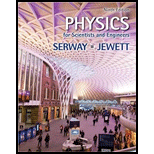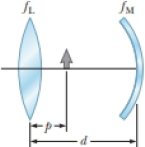
Concept explainers
Why is the following situation impossible? Consider the lens–mirror combination shown in Figure P35.55. The lens has a focal length of fL = 0.200 m, and the mirror has a focal length of fM = 0.500 m. The lens and mirror are placed a distance d = 1.30 m apart, and an object is placed at p = 0.300 m from the lens. By moving a screen to various positions to the left of the lens, a student finds two different positions of the screen that produce a sharp image of the object. One of these positions corresponds to light leaving the object and traveling to the left through the lens. The other position corresponds to light traveling to the right from the object, reflecting from the mirror and then passing through the lens.
Figure P35.55 Problem 55 and 57.

Want to see the full answer?
Check out a sample textbook solution
Chapter 36 Solutions
PHYSICS 1250 PACKAGE >CI<
- What functional form do you expect to describe the motion of a vibrating membrane without damping and why?arrow_forwardIf speed is tripled, how much larger will air drag become for an object? Show the math.arrow_forwardWhat does it tell us about factors on which air drag depends if it is proportional to speed squared?arrow_forward
- What is the net charge on a sphere that has the following? x (a) 5.75 × 106 electrons and 8.49 × 106 protons 4.39e-13 What is the charge of an electron? What is the charge of a proton? C (b) 200 electrons and 109 protons 1.60e-10 What is the charge of an electron? What is the charge of a proton? Carrow_forwardA spider begins to spin a web by first hanging from a ceiling by his fine, silk fiber. He has a mass of 0.025 kg and a charge of 3.5 μC. A second spider with a charge of 4.2 μC rests in her own web exactly 2.1 m vertically below the first spider. (a) What is the magnitude of the electric field due to the charge on the second spider at the position of the first spider? 8.57e3 N/C (b) What is the tension in the silk fiber above the first spider? 0.125 How does the electric field relate to the force? How do you calculate the net force? Narrow_forwardPoint charges of 6.50 μC and -2.50 μC are placed 0.300 m apart. (Assume the negative charge is located to the right of the positive charge. Include the sign of the value in your answers.) (a) Where can a third charge be placed so that the net force on it is zero? 0.49 m to the right of the -2.50 μC charge (b) What if both charges are positive? 0.185 xm to the right of the 2.50 μC chargearrow_forward
- c = ad Find the electric field at the location of q, in the figure below, given that q₁ = 9₁ = 9₁ = +4.60 nC, q=-1.00 nC, and the square is 20.0 cm on a side. (The +x axis is directed to the right.) magnitude direction N/C ° counterclockwise from the +x-axis 9a % 9 9barrow_forwardPlastic beads can often carry a small charge and therefore can generate electric fields. Three beads are oriented such that 92 is between q₁ and 93. The sum of the charge on 9₁ and 92 is 9₁ + 92 = −2.9 µС, and the net charge of the system of all three beads is zero. E field lines 93 92 What charge does each bead carry? 91 92 -1.45 What is the net charge of the system? What charges have to be equal? μC 2.9 ✓ What is the net charge of the system? What charges have to be equal? μC 93 2.9 μεarrow_forwardA spider begins to spin a web by first hanging from a ceiling by his fine, silk fiber. He has a mass of 0.025 kg and a charge of 3.5 μC. A second spider with a charge of 4.2 μC rests in her own web exactly 2.1 m vertically below the first spider. (a) What is the magnitude of the electric field due to the charge on the second spider at the position of the first spider? 8.57e3 N/C (b) What is the tension in the silk fiber above the first spider? 0.275 How does the electric field relate to the force? How do you calculate the net force? Narrow_forward
- Plastic beads can often carry a small charge and therefore can generate electric fields. Three beads are oriented such that 92 is between 91 system of all three beads is zero. E field lines 91 92 93 X What charge does each bead carry? 91 = 92 = ?2.9 0 μC × What is the net charge of the system? What charges have to be equal? μC 93 2.9 με and 93. The sum of the charge on 91 and 92 is 91 +92 = -2.9 μC, and the net charge of thearrow_forwardAn electron has an initial speed of 5.26 x 100 m/s in a uniform 5.73 x 105 N/C strength electric field. The field accelerates the electron in the direction opposite to its initial velocity. (a) What is the direction of the electric field? opposite direction to the electron's initial velocity same direction as the electron's initial velocity not enough information to decide × What is the direction of the force on the electron? How does it compare to the direction of the electric field, considering the sign of the electron's charge? (b) How far does the electron travel before coming to rest? 0.0781 × What kinematic equation is relevant here? How do you calculate the force due to the electric field? m (c) How long does it take the electron to come to rest? 5.27e8 What is the final velocity of the electron? s (d) What is the electron's speed when it returns to its starting point? 5.26e6 m/sarrow_forward(a) What magnitude point charge creates a 90,000 N/C electric field at a distance of 0.235 m? 5.53e-7 C (b) How large is the field at 22.2 m? 9e4 Using the equation for the electric field due to a point charge, and knowing the charge from part (a), can you solve for the field? N/Carrow_forward
 Physics for Scientists and EngineersPhysicsISBN:9781337553278Author:Raymond A. Serway, John W. JewettPublisher:Cengage Learning
Physics for Scientists and EngineersPhysicsISBN:9781337553278Author:Raymond A. Serway, John W. JewettPublisher:Cengage Learning Physics for Scientists and Engineers with Modern ...PhysicsISBN:9781337553292Author:Raymond A. Serway, John W. JewettPublisher:Cengage Learning
Physics for Scientists and Engineers with Modern ...PhysicsISBN:9781337553292Author:Raymond A. Serway, John W. JewettPublisher:Cengage Learning Principles of Physics: A Calculus-Based TextPhysicsISBN:9781133104261Author:Raymond A. Serway, John W. JewettPublisher:Cengage Learning
Principles of Physics: A Calculus-Based TextPhysicsISBN:9781133104261Author:Raymond A. Serway, John W. JewettPublisher:Cengage Learning College PhysicsPhysicsISBN:9781285737027Author:Raymond A. Serway, Chris VuillePublisher:Cengage Learning
College PhysicsPhysicsISBN:9781285737027Author:Raymond A. Serway, Chris VuillePublisher:Cengage Learning Physics for Scientists and Engineers, Technology ...PhysicsISBN:9781305116399Author:Raymond A. Serway, John W. JewettPublisher:Cengage Learning
Physics for Scientists and Engineers, Technology ...PhysicsISBN:9781305116399Author:Raymond A. Serway, John W. JewettPublisher:Cengage Learning Physics for Scientists and Engineers: Foundations...PhysicsISBN:9781133939146Author:Katz, Debora M.Publisher:Cengage Learning
Physics for Scientists and Engineers: Foundations...PhysicsISBN:9781133939146Author:Katz, Debora M.Publisher:Cengage Learning





